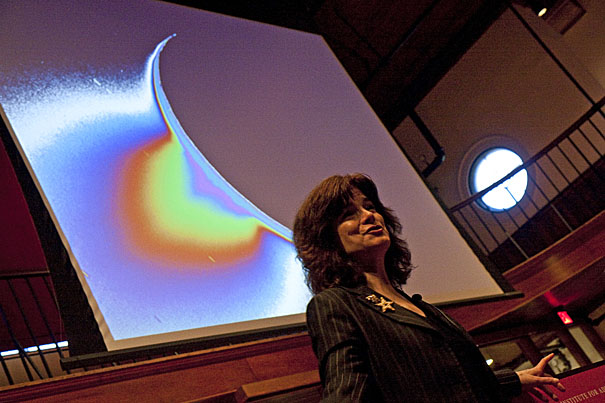
This photo of Saturn was taken during an eclipse of the sun, explained Carolyn Porco, the director of flight operations and imaging team leader for the Cassini spacecraft in orbit around Saturn.
Jon Chase/Harvard Staff Photographer
Looking for life beyond Earth
Scientist says Saturn spacecraft is filling in knowledge gaps
Could life exist beyond our own blue planet? According to scientist Carolyn Porco, it’s certainly possible.
Porco is the director of flight operations and imaging team leader for the Cassini spacecraft in orbit around Saturn. Her work involves taking detailed pictures in space, shots that offer insights into the nature of the universe, and signs of life elsewhere in the solar system.
“Gorgeous” was how she described the Cassini images to a crowd at the Radcliffe Gymnasium in a talk on April 1. Her listeners agreed.
There was a collective gasp from the student-filled audience as she showed a photo of Saturn taken during an eclipse of the sun. The negative-looking image revealed a sharp outline of the planet and its surrounding rings.
Porco spoke as part of the Radcliffe Institute for Advanced Study Dean’s Lecture Series. The lectures are part of the institute’s Academic Engagement Programs (AEP), which sponsor projects with Harvard faculty, Radcliffe Institute fellows, and Harvard students in scholarly and research endeavors.
The Cassini mission, which began in 1997, has been studying Saturn and its diverse system of moons, sending back stunning images and even evidence that life could exist 932 million miles from Earth.
Some of the mission’s highlights involve analysis of Saturn’s rings, their makeup, the gaps between them, and little “moonlettes.” The study of such moonlettes and the gaps they influence provides a “giant touchstone” for understanding how planets are formed, noted the scientist, who also discussed two of the planet’s moons in detail, Titan and its much smaller counterpart, Enceladus.
With Titan having an atmosphere vaguely similar to the Earth’s, including the presence of molecular nitrogen, as well as a troposphere and stratosphere, researchers were eager to get a closer look at the large moon in orbit around Saturn. They did, with the help of Huygens, a European-designed probe that landed on Titan’s surface in 2005. The event was worthy of a ticker tape parade, said an emotional Porco, who recalled seeing grown men brought to tears when the probe landed.
“This was like a Jules Verne adventure come true,” said Porco. “It was the day humanity landed a device of our making in the outer solar system.”
The images sent back from the probe were “outrageously easy to interpret,” said Porco, and included shots of a branching “dendritic drainage pattern” on the moon’s surface, one that only could have been formed by the flow of liquids. There also were photos of mountainous regions and a series of dunes.
The data revealed that Titan “was alien and exotic and yet strangely Earth-like” in its geological and geographical complexity.
On the small, icy moon Enceladus, “the mother lode of all discoveries was discovered at the South Pole,” said Porco. She described Cassini’s findings of elevated temperatures in the moon’s polar region, as well as an enormous plume of icy particles shooting tens of thousands of kilometers into space.
Analysis of the icy trail, which includes water vapor and trace amounts of organic materials such as methane, carbon dioxide, and propane, suggests it is fueled by geysers erupting from a pocket of salt water within the moon.
The findings, noted Porco, point to the possibility of “an environment where life itself might be stirring.”
“Should we ever discover that a second genesis had occurred in our solar system, independently outside the Earth,” she added, “then I think at that point the spell is broken. The existence theorem has been proven, and we could safely infer from it that life was not a bug but a feature of the universe in which we live, that it’s commonplace and has occurred a staggering number of times.”





